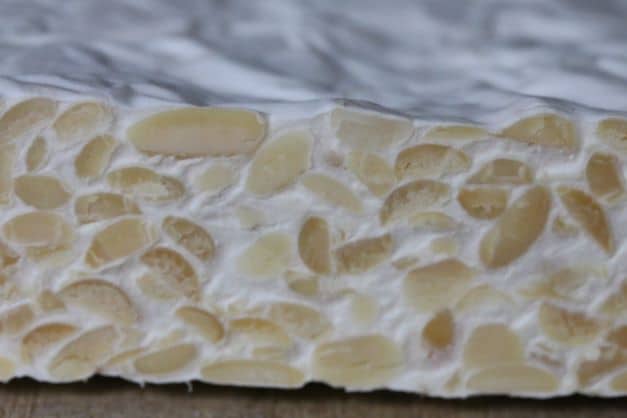When you make natto or tempeh, some of the spores will get airborn. Maybe you wonder if natto spores can contaminate tempeh and vica versa?
Bacillus subtilus is known as a important spoilage bacteria of tempeh. It will produce slimy and smelly spots in the tempeh, especially if the tempeh is not well acidified, too wet or incubated at too high temperature. On the other hand, when you are making natto, Rhizopus can also grow on the soybeans. Will the natto spores outgrow the Rhizopus? To answer these questions we deliberately contaminated the soybeans with the other spores.
Test 1: Natto contaminated with Rhizopus spores
We made natto using the method that you can find on our DIY pages, but we allowed one bottle to cool down to below 40°C and contaminated the soybeans with 0.1g tempeh starter per kg soybeans. This is a very high level of contamination. The finale natto had same taste, smell and appearance as uncontaminated natto. Natto is incubated at 40°C but once the fermentation takes off the temperature in the soybeans increases to between 45° and 50°C. At this high temperature the Rhizopus growth is inhibited.

Test 2: Tempeh contaminated with natto spores
We made tempeh using the method that you can find on our DIY pages. We contaminated the soybeans with 0.1g natto starter per kg soybeans at the same time when we added the tempeh starter. Also in this test we found no effect of the contamination on the final quality. The tempeh was perfect and showed no slimy spots and smelled nice and typical. Why do the Bacillus spores not spoil the tempeh? When making tempeh it is important to acidify the beans, either by adding an acid (vinegar or lactic acid) or by a natural lactic acid fermentation. Bacillus cannot grow on such acidified beans. Once the Rhizopus colonizes the soybeans the acidity will decrease (pH increases) and conditions become favorable for the growth of Bacillus. The Rhizopus seems to inhibit the growth of Bacillus.

Conclusion
It is possible to make natto and tempeh in the same kitchen, when following the correct procedures. If spoilage does occur it means that there is a mistake in your fermentation procedure. For example, making tempeh with unacidified beans or fermenting natto at too low temperature.
Please note that this conclusion is only valid for the tempeh starter and natto starter from TopCultures. Starters from other suppliers may contain different strains with different characteristics.
